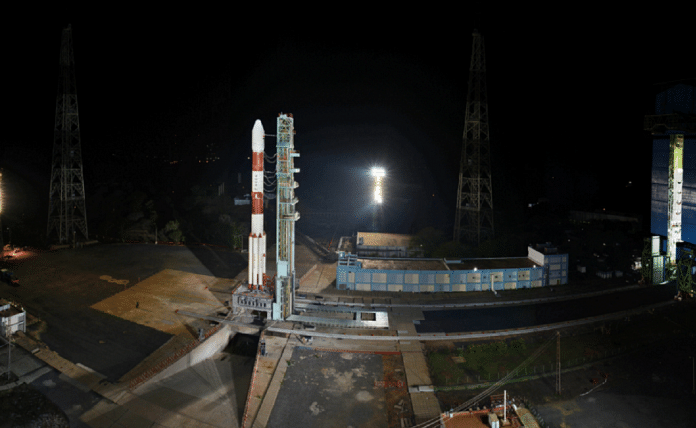The assembly, integration and testing for IRNSS-1I was done by a consortium of private companies led by defence equipment supplier in Bengaluru.
Bengaluru: The Indian Space Research Organisation (ISRO) will make a second attempt Thursday to launch a satellite that has had its assembly, integration, and testing (AIT) done by private companies.
AIT involves the process of putting together all the manufactured components in the satellite’s body and testing them rigorously to ensure it can fly. For this satellite, AIT was done by a group of engineers from private firms, with ample handholding by ISRO, which is hoping to completely delegate AIT to private companies in the near future.
Indian Regional Navigation Satellite System (IRNSS)-1I is set for take off aboard the faithful Polar Satellite Launch Vehicle (PSLV) at 4.04 am from Sriharikota. It is the latest addition to the ‘Navigation with Indian Constellation (NAVIC)’, a group of satellites orbiting above India that will serve as a domestic version of the American government-owned GPS.
Private technology
ISRO’s earlier attempt to launch a satellite, IRNSS-1H, with private AIT involvement, in August 2017, failed.
While ISRO does source materials and components from private players for all their launches, AIT has always been performed exclusively by the ISRO Satellite Assembly Centre (ISAC), with involvement by the state-run Hindustan Aeronautics Limited (HAL).
The AIT for IRNSS-1I was done by a consortium of private companies led by Alpha Design Technologies, a defence equipment supplier based in Bengaluru. The companies, however, were not involved in the planning or manufacture of IRNSS-1I per se, contrary to the several reports that claim it is fully privately built.
Rocket and Flight profile
The rocket currently sitting on the launch pad will be called PSLV-C41. It will mark the 43rd flight for the PSLV. The carrier has four stages, alternating between solid and liquid fuels, stacked on top of each other. The PSLV weighs 321,000 kg and stands 44.4 m tall. There will be six strap-on boosters attached to the first stage to give the PSLV the additional thrust needed to climb higher.
As the rocket flies on its designated path off the coast of Chennai, the different stages ignite and separate from the rocket at specified times. The boosters will separate first, at 23.6 km, followed by the first stage at 55 km. The second stage’s Vikas engine will carry the rocket out of the atmosphere, at which point the heat shield that protected the satellite through layers of air will separate to reduce weight, at 113 km.
The second stage will separate at 131.5 km, followed by the third at 183 km. The fourth stage then helps the satellite climb higher, separating at 454.5 km. The satellite will finally be placed into the required orbit 19 minutes into the flight.
After the satellite is pushed into its preliminary orbit, the master control facility (MCF) at Hassan, Karnataka, will guide it through three orbit-raising manoeuvres with the help of engines on-board the IRNSS-1I. The satellite will adjust its orbit from the initial 284 km x 20,650 km elliptical path to a circular one at 36,000 km.
Payload
Of the seven satellites in NAVIC, built to provide fast and efficient navigation in India, two were built as backups.
In July 2016, all three atomic clocks on the very first satellite, IRNSS-1A failed. These clocks had been made by a leading Swiss firm, Spectratime, which provides timekeeping devices to navigation satellites the world over, including China’s Compass constellation. Clocks from the same manufacturer aboard satellites to be launched into the European constellation Galileo had failed too.
IRNSS-1H was ISRO’s first backup satellite, launched in August 2017 with the intention of replacing IRNSS-1A. However, PSLV-C39’s payload fairing failed to separate, leaving the satellite stuck inside.
While IRNSS-1I will replace IRNSS-1A, ISRO has no intention of de-orbiting the latter. “IRNSS-1A will continue to remain in orbit for messaging purposes,” the ISRO spokesperson confirmed to ThePrint. This means that, even though the satellite will not be able to accurately provide navigational information, it will be used to transmit signals between all the other satellites in the network and the ground stations.
IRNSS is intended to be used for both civilian and military purposes. The Indian Air Force is expected to switch from GPS to IRNSS when it is deemed fully functional and transponders required to receive IRNSS signals are available.
******
Mission: PSLV-C41/IRNSS-1I
Launch: 4:04 am, 12 April 2018.
Location: First Launch Pad at Sriharikota, India
Rocket: PSLV-C41, XL configuration
Payload: Navigation satellite IRNSS-1I
Injection orbit: 284 km x 20,650 km , 19.2 deg
Final satellite orbit: 36,000 km GEO, 29 deg






